Un-Official Illustrated Rex Standard
 Please note that this is an unofficial description of the Standard Rex Rabbit. The official rabbit organization in North America is the American Rabbit Breeder's Association (ARBA). Copies of the official standard may be purchased through them.
Please note that this is an unofficial description of the Standard Rex Rabbit. The official rabbit organization in North America is the American Rabbit Breeder's Association (ARBA). Copies of the official standard may be purchased through them.
Please note also that the images do not necessarily illustrate the perfect specimen. They are intended to be representative and to allow the reader a basis for comparison. All pictures copyright Mink Hollow Farm Permission to use these photos must be granted before they can be used.
<html>
<FORM action=https://www.paypal.com/cgi-bin/webscr method=post>
<INPUT type=image alt=“Make payments with PayPal - it's fast, free and secure!” src=“https://www.paypal.com/en_US/i/btn/x-click-but21.gif” border=0 name=submit>
<IMG height=1 textalign=“right” alt=“” src=“https://www.paypal.com/en_US/i/scr/pixel.gif” width=1 border=0 >
<FONT face=Verdana size=1 text-align=right><br>If you find this information useful, please consider making a [paypal] donation to help us maintain and improve it.</FONT>
<INPUT type=hidden value=_s-xclick name=cmd>
<INPUT type=hidden value=“—–BEGIN PKCS7—–MIIHXwYJKoZIhvcNAQcEoIIHUDCCB0wCAQExggEwMIIBLAIBADCBlDCBjjELMAkGA1UEBhMCVVMxCzAJBgNVBAgTAkNBMRYwFAYDVQQHEw1Nb3VudGFpbiBWaWV3MRQwEgYDVQQKEwtQYXlQYWwgSW5jLjETMBEGA1UECxQKbGl2ZV9jZXJ0czERMA8GA1UEAxQIbGl2ZV9hcGkxHDAaBgkqhkiG9w0BCQEWDXJlQHBheXBhbC5jb20CAQAwDQYJKoZIhvcNAQEBBQAEgYCNIsZLQA6jCbLiSI5lR2rDCJHPnld6VVzExEKczllfYWnPmzH1WY/bwqwv2pHs8brp3KW2DAdjX82+scemtUJFSyzcBrWWJjc1lQt6K/8YXJSAqbV0ptfkyM6VjdMwEBpjvr71qkqMesG6ALBJctuK2beqQoNWnLzPo/pQz4PjELMAkGBSsOAwIaBQAwgdwGCSqGSIb3DQEHATAUBggqhkiG9w0DBwQIw4Jvi5bH1/aAgbjFf5Pnsv64CM3nS4fVVeWi+6t1YJowAWB9Vn9suW4KoD4tLeKCQR3kP1yNHnuw+XgECTiTnLCJZ/pw7YSTqAT+ObYhnCY3KnEia9+RIMRw9c0Zi4dGogK2/HVGm/G+qNbqmxtscI+2K3up+zUBk9vOVwy4W+GP2Gjv7zZh3ZQCWQvPsDCDTf8oURPyP7bC/OKJ48paqbdrPGdURyenMVQZ4frZvknPutQ0R96MFcRHxtwij7Wn/B6toIIDhzCCA4MwggLsoAMCAQICAQAwDQYJKoZIhvcNAQEFBQAwgY4xCzAJBgNVBAYTAlVTMQswCQYDVQQIEwJDQTEWMBQGA1UEBxMNTW91bnRhaW4gVmlldzEUMBIGA1UEChMLUGF5UGFsIEluYy4xEzARBgNVBAsUCmxpdmVfY2VydHMxETAPBgNVBAMUCGxpdmVfYXBpMRwwGgYJKoZIhvcNAQkBFg1yZUBwYXlwYWwuY29tMB4XDTA0MDIxMzEwMTMxNVoXDTM1MDIxMzEwMTMxNVowgY4xCzAJBgNVBAYTAlVTMQswCQYDVQQIEwJDQTEWMBQGA1UEBxMNTW91bnRhaW4gVmlldzEUMBIGA1UEChMLUGF5UGFsIEluYy4xEzARBgNVBAsUCmxpdmVfY2VydHMxETAPBgNVBAMUCGxpdmVfYXBpMRwwGgYJKoZIhvcNAQkBFg1yZUBwYXlwYWwuY29tMIGfMA0GCSqGSIb3DQEBAQUAA4GNADCBiQKBgQDBR07d/ETMS1ycjtkpkvjXZe9k+6CieLuLsPumsJ7QC1odNz3sJiCbs2wC0nLE0uLGaEtXynIgRqIddYCHx88pb5HTXv4SZeuv0Rqq4+axW9PLAAATU8w04qqjaSXgbGLP3NmohqM6bV9kZZwZLR/klDaQGo1u9uDb9lr4Yn+rBQIDAQABo4HuMIHrMB0GA1UdDgQWBBSWn3y7xm8XvVk/UtcKG+wQ1mSUazCBuwYDVR0jBIGzMIGwgBSWn3y7xm8XvVk/UtcKG+wQ1mSUa6GBlKSBkTCBjjELMAkGA1UEBhMCVVMxCzAJBgNVBAgTAkNBMRYwFAYDVQQHEw1Nb3VudGFpbiBWaWV3MRQwEgYDVQQKEwtQYXlQYWwgSW5jLjETMBEGA1UECxQKbGl2ZV9jZXJ0czERMA8GA1UEAxQIbGl2ZV9hcGkxHDAaBgkqhkiG9w0BCQEWDXJlQHBheXBhbC5jb22CAQAwDAYDVR0TBAUwAwEB/zANBgkqhkiG9w0BAQUFAAOBgQCBXzpWmoBa5e9fo6ujionW1hUhPkOBakTr3YCDjbYfvJEiv/2P+IobhOGJr85+XHhN0v4gUkEDI8r2/rNk1m0GA8HKddvTjyGw/XqXa+LSTlDYkqI8OwR8GEYj4efEtcRpRYBxV8KxAW93YDWzFGvruKnnLbDAF6VR5w/cCMn5hzGCAZowggGWAgEBMIGUMIGOMQswCQYDVQQGEwJVUzELMAkGA1UECBMCQ0ExFjAUBgNVBAcTDU1vdW50YWluIFZpZXcxFDASBgNVBAoTC1BheVBhbCBJbmMuMRMwEQYDVQQLFApsaXZlX2NlcnRzMREwDwYDVQQDFAhsaXZlX2FwaTEcMBoGCSqGSIb3DQEJARYNcmVAcGF5cGFsLmNvbQIBADAJBgUrDgMCGgUAoF0wGAYJKoZIhvcNAQkDMQsGCSqGSIb3DQEHATAcBgkqhkiG9w0BCQUxDxcNMDcxMTMwMjAwNjQ3WjAjBgkqhkiG9w0BCQQxFgQUksa+GmavzkxvvXXoAWLfLtusQYYwDQYJKoZIhvcNAQEBBQAEgYB7OVn+c8kZrGablDfqfUGjUGwZCvLh3mnG8CvLjFdbxZzK1YBqe0TSGn2pqzti7eGrZ5F8gv+N2m043VMSPYH8a+uEF9KE8zL/1oGmTSCdgmvsCb0xRASc74rm9DJtfMFgKYYMzUkNguRAmBes0jg8LGPcHJUEW59nPNQEtS+3Xw==—–END PKCS7—– ” name=encrypted>
</FORM>
</html>
For an illustrated explanation of rabbit coat colour genetics, follow this link.
<code>
POINTS:
General Type………………….45
Body……………………..35
Head………………………3
Ears………………………3
Eyes………………………1
Feet & Legs………………..2
Tail………………………1
Fur…………………………40
Color……………………….10
Condition…………………….5
</code>
 16 Varieties: Amber, Black, Blue, Broken, Californian, Castor, Chinchilla, Chocolate, Lilac, Lynx, Opal, Otter(all four varieties), Red, Sable, Seal, White (REW).
(4 class rabbit)
16 Varieties: Amber, Black, Blue, Broken, Californian, Castor, Chinchilla, Chocolate, Lilac, Lynx, Opal, Otter(all four varieties), Red, Sable, Seal, White (REW).
(4 class rabbit)
|Senior Bucks |6 months of age & over, 7 1/2 to 9 1/2 pounds. Ideal weight of 8 pounds. |
|Senior Does |6 months of age & over, 8 to 10 1/2 pounds. Ideal weight of 9 pounds. |
|Junior Bucks |Under 6 months of age, 4 to 8 pounds |
|Junior Does |Under 6 months of age, 4 to 8 1/2 pounds |
===== General Type =====
(body, head, ears, eyes, feet, legs, & tail
==== Body ====
 The Ideal Rex is a well proportioned animal that gives the impression of balance and uniformity. The animal should exemplify meat producing qualities, having medium body length, well rounded hips, well filled loin, ribs, and shoulders that balance with the rest of the body. The body is to have enough depth to balance to other portions. Top line should rise in a gradual curve from the base of the ears to the center of the hip and then fall in a smooth curve down to the base of the tail. Legs must be short enough to dispel any appearance of raciness or of being rangy. Bone is to be medium.
==== Shoulders ====
Shoulders are to be well developed and well filled, balancing with rib spread and hips. They should be slightly narrower in width and slightly lower than the hips.
==== Back & Sides ====
The Ideal Rex is a well proportioned animal that gives the impression of balance and uniformity. The animal should exemplify meat producing qualities, having medium body length, well rounded hips, well filled loin, ribs, and shoulders that balance with the rest of the body. The body is to have enough depth to balance to other portions. Top line should rise in a gradual curve from the base of the ears to the center of the hip and then fall in a smooth curve down to the base of the tail. Legs must be short enough to dispel any appearance of raciness or of being rangy. Bone is to be medium.
==== Shoulders ====
Shoulders are to be well developed and well filled, balancing with rib spread and hips. They should be slightly narrower in width and slightly lower than the hips.
==== Back & Sides ====
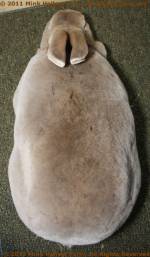 Back and sides are to be broad, firm, and meaty, carrying as much flesh as possible on both sides of the spine and throughout its entire length. Side line should taper slightly from hindquarters towards shoulders. Side appearance should be of good depth to confirm with width of body. The belly should be firm.
==== Hindquarters ====
Back and sides are to be broad, firm, and meaty, carrying as much flesh as possible on both sides of the spine and throughout its entire length. Side line should taper slightly from hindquarters towards shoulders. Side appearance should be of good depth to confirm with width of body. The belly should be firm.
==== Hindquarters ====
 Hindquarters are to be broad, smooth, and well filled with solid, firm flesh. Lower sides of hips and back are to be well developed. Hindquarters are to be slightly larger and deeper, but balancing closely with the shoulders.
Faults: Narrow shoulders; long, narrow body; pottiness; extremely short coupled body; chopped off and undercut hindquarters; fine bone.
Hindquarters are to be broad, smooth, and well filled with solid, firm flesh. Lower sides of hips and back are to be well developed. Hindquarters are to be slightly larger and deeper, but balancing closely with the shoulders.
Faults: Narrow shoulders; long, narrow body; pottiness; extremely short coupled body; chopped off and undercut hindquarters; fine bone.
Disqualifications from competition: Extreme raciness or ranginess.
==== Head ====
 Head is to be broad and set close on the shoulders. To be in proportion and harmonize with the body
Faults: Narrow head; pointed nose; small head that does not balance with the body.
Head is to be broad and set close on the shoulders. To be in proportion and harmonize with the body
Faults: Narrow head; pointed nose; small head that does not balance with the body.
=== Ears ===
 Ears are to be medium thick, well set on head, and in proportion to body. Ears are to be carried erect.
Faults: Thin ears; large ears that do not balance with the body.
Ears are to be medium thick, well set on head, and in proportion to body. Ears are to be carried erect.
Faults: Thin ears; large ears that do not balance with the body.
=== Eyes ===
Eyes are to be bright and bold;
* brown on: Amber, Black, Black Otter, Castor, Chinchilla, Chocolate, Chocolate Otter, Red, Sable, and Seal;
* blue gray on: Blue, Blue Otter, Lilac, Lilac Otter, Lynx, and Opal;
* pink/ruby on Californian and White.
|  |
| 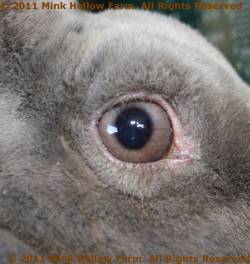 |
|  |
=== Feet & Legs ===
|
=== Feet & Legs ===

 Feet and legs are to be of medium bone, straight, and rather short in length. Feet should be well padded.
Faults: Long legs, giving impression of raciness or ranginess; too fine bone.
Feet and legs are to be of medium bone, straight, and rather short in length. Feet should be well padded.
Faults: Long legs, giving impression of raciness or ranginess; too fine bone.
Disqualifications from competition: Toenails not matching on same foot and on corresponding foot, except on brokens.
==== Tail ====
 To be well carried, in proportion, and to harmonize with the size of the body.
===== Fur =====
To be well carried, in proportion, and to harmonize with the size of the body.
===== Fur =====

 Fur is to be extremely dense with length no less than 1/2 inch or more than 7/8 inch, ideal length is 5/8 inch. Fur is to be straight, upright, and as nearly as possible, the same length and texture over the entire body. Fur is to have a lustrous appearance. Guard hairs are to be very plentiful and evenly distributed, but not too noticeably protruding. Fur is to be of good body and plush like effect, offering a distinct springy resistance to the touch. It should feel extremely smooth to the touch, but must not have a soft silky texture, which would destroy the springiness.
Fur is to be extremely dense with length no less than 1/2 inch or more than 7/8 inch, ideal length is 5/8 inch. Fur is to be straight, upright, and as nearly as possible, the same length and texture over the entire body. Fur is to have a lustrous appearance. Guard hairs are to be very plentiful and evenly distributed, but not too noticeably protruding. Fur is to be of good body and plush like effect, offering a distinct springy resistance to the touch. It should feel extremely smooth to the touch, but must not have a soft silky texture, which would destroy the springiness.
Faults: Dullness or lack of luster; noticeably protruding guard hair, particularly if curly; coarse, harsh, or wiry texture; wavy or uneven appearance; soft or silky texture; lack of guard hairs, causing fur to lie flat when stroked.
Disqualifications from competition: Any of the above faults, severe enough to destroy typical Rex appearance; average fur length less than 1/2 inch or more than 7/8 inch.
===== Color =====
Note: Colors that are commented in red are new to the standard and are not in the Standard of Perfection, 2006-2010 edition. They are however in the 2011-2015 (current) edition.
==== Amber ====
| |
| |
|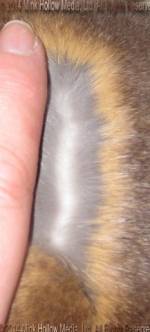 |
|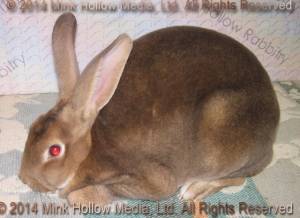 |
(showable as of feb. 1st, 2008) Surface color is to be light reddish-brown, carried well down he sides, lightly, and evenly tipped with chocolate. Intermediate ring color is to be golden orange, clearly defined over dove-gray undercolor. Belly is to be white or tan over dove-gray undercolor. Ruby cast over eyes permissible.
Faults: Indistinct intermediate band; failure to show dove-gray undercolor on the belly. Lack of gray undercolor implies that it is a smutty red rather than a chocolate agouti.
==== Black ====
|
|
(showable as of feb. 1st, 2008) Surface color is to be light reddish-brown, carried well down he sides, lightly, and evenly tipped with chocolate. Intermediate ring color is to be golden orange, clearly defined over dove-gray undercolor. Belly is to be white or tan over dove-gray undercolor. Ruby cast over eyes permissible.
Faults: Indistinct intermediate band; failure to show dove-gray undercolor on the belly. Lack of gray undercolor implies that it is a smutty red rather than a chocolate agouti.
==== Black ====
| |
| }|
}| |
| |
Color is to be a rich, lustrous jet black over the entire body, running deep towards the skin.
Faults: Brown or rusty color; white hairs; faded
==== Blue ====
|
|
Color is to be a rich, lustrous jet black over the entire body, running deep towards the skin.
Faults: Brown or rusty color; white hairs; faded
==== Blue ====
|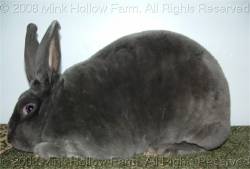 |
| |
| |
|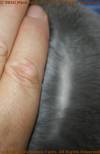 |
Color is to be a dark, rich blue over the entire body, running deep towards the skin. Guard hairs are to be the same color.
|
Color is to be a dark, rich blue over the entire body, running deep towards the skin. Guard hairs are to be the same color.
Faults: Faded or rusty color; white hairs; frostiness or mealiness.
==== Broken ====
|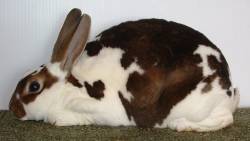 |
|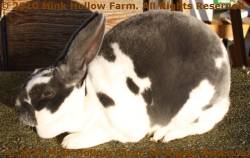 |
| |
Color is to include any recognized breed variety in conjunction with white, or white in conjunction with one of the following combination of two colors: Dense Black & Golden Orange; Lavender Blue & Golden Fawn; Dark Chocolate Brown & Golden Orange; Dove Gray & Golden Fawn.
=== Pattern ===
|
|
Color is to include any recognized breed variety in conjunction with white, or white in conjunction with one of the following combination of two colors: Dense Black & Golden Orange; Lavender Blue & Golden Fawn; Dark Chocolate Brown & Golden Orange; Dove Gray & Golden Fawn.
=== Pattern ===
|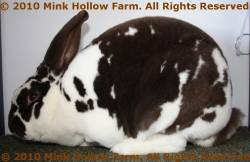 |
|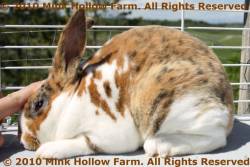 |
| |
Pattern is to have both ears colored, nose marking (no preference is given to butterfly over evenly balanced nose spots), color around both eyes, and a back pattern. The back pattern may be in the form of a blanket ( color starting at the nape of the neck, continuing over the back, sides, and hips) or spotted ( individual colored spots evenly distributed over the back sides and hips), with preference given to the balance of pattern. Color on a broken patterned animal is to be at least 10%, but not over 50% of the entire animal.
== Note ==
The 10 points for color shall be distributed as follows: color 5 points, pattern 5 points.
Faults: Unbalanced or one spotted nose marking; one or more colored toenails.
|
Pattern is to have both ears colored, nose marking (no preference is given to butterfly over evenly balanced nose spots), color around both eyes, and a back pattern. The back pattern may be in the form of a blanket ( color starting at the nape of the neck, continuing over the back, sides, and hips) or spotted ( individual colored spots evenly distributed over the back sides and hips), with preference given to the balance of pattern. Color on a broken patterned animal is to be at least 10%, but not over 50% of the entire animal.
== Note ==
The 10 points for color shall be distributed as follows: color 5 points, pattern 5 points.
Faults: Unbalanced or one spotted nose marking; one or more colored toenails.
Disqualifications from competition: Absence of color on either ear, around eyes, or nose marking. Coloration less than 10% or more than 50% in judges opinion. Excessive scattered white hairs or silvering in colored areas.
==== Californian ====
The entire body is to be pure, clean white, except for the nose, ears, feet, and tail, which are to be as black as possible. Eye stain permissible.
Disqualifications from competition:
Any color or smut on any usable part of the pelt (dewlap excluded); absence of color on nose, ears, feet, or tail; definite white spot on colored markings; any point color other than black. Do not disqualify for molting, frosting, or dilution, which may make black point color appear faded or indistinct.
|  |
|  | fur | other |
==== Castor ====
| fur | other |
==== Castor ====

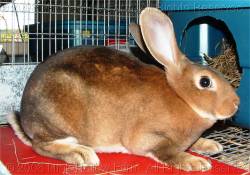 Color is to be rich, dark chestnut or mahogany brown, as even as possible over body, head, and legs. Intermediate ring color to be a rich orange or rufus red, clearly defined over slate blue undercolor. Fur to be lightly and evenly tipped with black. Belly color to be white or tan over slate blue undercolor.
Faults: Heavy black top; gray effect instead of brown; white tipped, giving salt and pepper effect; barred front feet; failure to show blue undercolor on belly.
|
Color is to be rich, dark chestnut or mahogany brown, as even as possible over body, head, and legs. Intermediate ring color to be a rich orange or rufus red, clearly defined over slate blue undercolor. Fur to be lightly and evenly tipped with black. Belly color to be white or tan over slate blue undercolor.
Faults: Heavy black top; gray effect instead of brown; white tipped, giving salt and pepper effect; barred front feet; failure to show blue undercolor on belly.
|  |
|  |
|  |
| 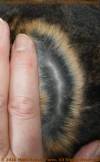 |
==== Chinchilla ====
|
==== Chinchilla ====
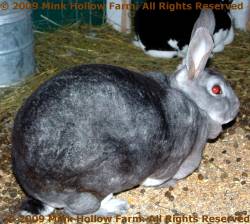 Color is to resemble real chinchilla. The undercolor is to be a dark slate at the base. Intermediate portion of pearl is to be as light as possible (base to be definitely wider than intermediate portion), with top edge being a very narrow black band, above this is a very light band brightly ticked with black hairs. Either wavy or even ticking permissible to make the beautiful chinchilla surface color. Neck fur is lighter in color than the body, but strictly confined to the nape of the neck. The chest is to be lightly ticked with a uniform shade of pearl, slightly lighter than the body. The body color is to extend as far down the sides as possible. The belly surface color is to be white. Eye circles are to be well defined, narrow, and light pearl in color. Blue gray eyes permissible.
Faults: Rust or yellow tinge; salt and pepper effect, caused by too much white tipping; heavy black top; narrow or muddy ring color; barred front feet.
Color is to resemble real chinchilla. The undercolor is to be a dark slate at the base. Intermediate portion of pearl is to be as light as possible (base to be definitely wider than intermediate portion), with top edge being a very narrow black band, above this is a very light band brightly ticked with black hairs. Either wavy or even ticking permissible to make the beautiful chinchilla surface color. Neck fur is lighter in color than the body, but strictly confined to the nape of the neck. The chest is to be lightly ticked with a uniform shade of pearl, slightly lighter than the body. The body color is to extend as far down the sides as possible. The belly surface color is to be white. Eye circles are to be well defined, narrow, and light pearl in color. Blue gray eyes permissible.
Faults: Rust or yellow tinge; salt and pepper effect, caused by too much white tipping; heavy black top; narrow or muddy ring color; barred front feet.
| 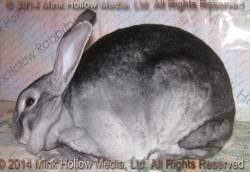 |
|  |
| 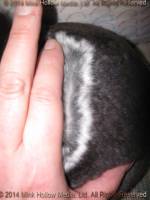 | other |
==== Chocolate ====
Color is to be a rich chocolate brown, running as deep towards the skin as possible. Color is to be even throughout. Undercolor is to be dove. Ruby cast over eyes permissible.
Faults: Faded or rusty color; white hairs; sunburn.
| body |
| other |
==== Chocolate ====
Color is to be a rich chocolate brown, running as deep towards the skin as possible. Color is to be even throughout. Undercolor is to be dove. Ruby cast over eyes permissible.
Faults: Faded or rusty color; white hairs; sunburn.
| body | 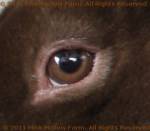 |
| 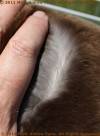 |
|  |
==== Lilac ====
Color is to be a pink dove-gray, with lustrous appearance, and even throughout. Guard hairs are to be the same color. Ruby cast over eyes permissible.
Faults: Blue or brown color. (True lilac is off the chocolate line, a dilute chocolate)
|
|
==== Lilac ====
Color is to be a pink dove-gray, with lustrous appearance, and even throughout. Guard hairs are to be the same color. Ruby cast over eyes permissible.
Faults: Blue or brown color. (True lilac is off the chocolate line, a dilute chocolate)
|  |
|  |
|  |
|  |
==== Lynx ====
|
==== Lynx ====
 Intermediate or ring color is to be as bright fawn as possible, clearly defined over white to off white undercolor. Fur is to be lightly and evenly tipped with lilac, not hiding the fawn, but giving a lustrous, lilac appearance. Belly is to be white/off white with an off white undercolor.
There is an ongoing debate over the correct genotype of a lynx. Some claim that it should be a dilute red or even a fawn tort, while others say it should be a lilac agouti. Rabbits are shown according to their PHENOTYPE rather than their GENOTYPE. This means they are shown according to how they look rather than what their genetic make-up says they are. Thus a poorly coloured Lynx can be shown as an Opal and vice-versa. The standard calls for ring colors as is typical of agoutis, but then requires a cream undercolor, which is unlike all the other agoutis. I once recall seeing a lilac tort shown as a lynx. It was disqualified for lack of ring colour and because it had darker points.
Intermediate or ring color is to be as bright fawn as possible, clearly defined over white to off white undercolor. Fur is to be lightly and evenly tipped with lilac, not hiding the fawn, but giving a lustrous, lilac appearance. Belly is to be white/off white with an off white undercolor.
There is an ongoing debate over the correct genotype of a lynx. Some claim that it should be a dilute red or even a fawn tort, while others say it should be a lilac agouti. Rabbits are shown according to their PHENOTYPE rather than their GENOTYPE. This means they are shown according to how they look rather than what their genetic make-up says they are. Thus a poorly coloured Lynx can be shown as an Opal and vice-versa. The standard calls for ring colors as is typical of agoutis, but then requires a cream undercolor, which is unlike all the other agoutis. I once recall seeing a lilac tort shown as a lynx. It was disqualified for lack of ring colour and because it had darker points.
Disqualifications from competition: Blue undercolor. (note: this implies the rabbit might be an opal rather than a lynx)
| |
| |
|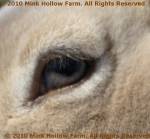 |
| |
|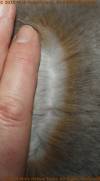 |
==== Opal ====
|
==== Opal ====
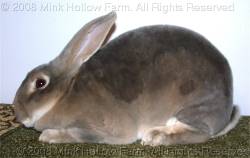 Top color is to be a rich, medium blue, carried well down the sides. Intermediate, or ring color, is to be golden tan, clearly defined over slate blue undercolor. Belly is to be white or tan, over blue undercolor.
Top color is to be a rich, medium blue, carried well down the sides. Intermediate, or ring color, is to be golden tan, clearly defined over slate blue undercolor. Belly is to be white or tan, over blue undercolor.
Faults: Failure to show blue undercolor on belly; white undercolor on any part of the body.
| body |  |
|  |
| 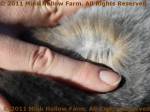 |
==== Otter ====
=== Black Otter ===
|
==== Otter ====
=== Black Otter ===
 Body color is to be jet black, uniform throughout, with slate blue undercolor next to the skin. Pattern: Underside of chin and tail are to be pale cream. Belly is to be a pale cream or pale cream (pale cream preferred) over slate blue, and divided from the body color by a distinct border of tan. Nostrils and triangle are to be tan. Eye circles and inside of the ears are to be fawn. Chest is to be an even mixture of black and tan, merging with the main body color. The forefeet shall be entirely black. The tan border between the belly and flanks shall continue down to the hind feet.
Body color is to be jet black, uniform throughout, with slate blue undercolor next to the skin. Pattern: Underside of chin and tail are to be pale cream. Belly is to be a pale cream or pale cream (pale cream preferred) over slate blue, and divided from the body color by a distinct border of tan. Nostrils and triangle are to be tan. Eye circles and inside of the ears are to be fawn. Chest is to be an even mixture of black and tan, merging with the main body color. The forefeet shall be entirely black. The tan border between the belly and flanks shall continue down to the hind feet.
| 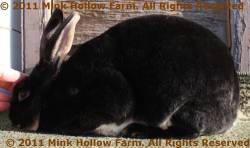 |
|  |
|  |
|  |
|
|
|  |
|  |
| 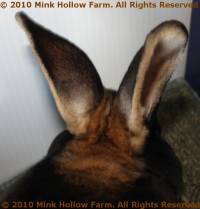 |
=== Blue Otter ===
|
=== Blue Otter ===
 (showable as of Feb. 1st 2009) Body color is to be a rich dark blue, running deep towards the skin, uniform throughout. Toenails to be pigmented and as dark as possible. Pattern: Underside of chin and tail are to be pale cream. Belly is to be a pale cream or pale cream (pale cream preferred) over slate blue, and divided from the blue body color by a distinct border of fawn. Nostrils and triangle are to be fawn. Eye circles and inside of the ears are to be pale cream. Chest is to be an even mixture of blue and fawn merging with the main body color. The forefeet shall be entirely blue. The fawn border between the belly and flanks shall continue down to the hind feet.
(showable as of Feb. 1st 2009) Body color is to be a rich dark blue, running deep towards the skin, uniform throughout. Toenails to be pigmented and as dark as possible. Pattern: Underside of chin and tail are to be pale cream. Belly is to be a pale cream or pale cream (pale cream preferred) over slate blue, and divided from the blue body color by a distinct border of fawn. Nostrils and triangle are to be fawn. Eye circles and inside of the ears are to be pale cream. Chest is to be an even mixture of blue and fawn merging with the main body color. The forefeet shall be entirely blue. The fawn border between the belly and flanks shall continue down to the hind feet.
|  |
|  | fur | other |
=== Chocolate Otter ===
| fur | other |
=== Chocolate Otter ===
 (showable as of Feb. 1st 2009) Body color is to be a rich chocolate brown, running as deep towards the skin as possible. Color is to be even throughout. Undercolor to be a dove color. Ruby cast over eyes permissible. Toenails are to be pigmented and as dark as possible. Pattern: Underside of chin and tail are to be pale cream. Belly is to be a pale cream or pale cream (pale cream preferred) over slate blue, and divided from the chocolate body color by a distinct border of tan. Nostrils and triangle are to be tan. Eye circles and inside of ears are to be pale cream. Chest is to be an even mixture of chocolate and tan merging with the main body color. The forefeet shall be entirely chocolate. The fawn border between the belly and flanks shall continue down to the hind feet.
(showable as of Feb. 1st 2009) Body color is to be a rich chocolate brown, running as deep towards the skin as possible. Color is to be even throughout. Undercolor to be a dove color. Ruby cast over eyes permissible. Toenails are to be pigmented and as dark as possible. Pattern: Underside of chin and tail are to be pale cream. Belly is to be a pale cream or pale cream (pale cream preferred) over slate blue, and divided from the chocolate body color by a distinct border of tan. Nostrils and triangle are to be tan. Eye circles and inside of ears are to be pale cream. Chest is to be an even mixture of chocolate and tan merging with the main body color. The forefeet shall be entirely chocolate. The fawn border between the belly and flanks shall continue down to the hind feet.
| 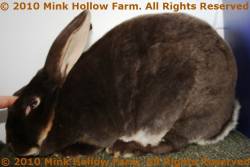 |
|  |
|  |
|  |
=== Lilac Otter ===
(showable as of Feb. 1st 2009) Body color to be a pink dove gray, with lustrous appearance and even throughout. Guard hairs are to be the same color. Ruby cast over eyes permissible. Toenails are to be pigmented and as dark as possible. Pattern: Underside of chin and tail are to be pale cream. Belly is to be a pale cream or pale cream (pale cream preferred) over slate blue, and divided from the lilac body color by a distinct border of fawn. Nostrils and triangle are to be fawn. Eye circles and inside of ears are to be pale cream. Chest is to be an even mixture of lilac and fawn merging with the main body color. The forefeet shall be entirely lilac. The fawn border between the belly and flanks shall continue down to the hind feet.
== Note ==
The 10 points for color shall be distributed as follows: color 5 points, pattern 5 points.
Faults: Brown or rusty tinge to the body color; white or tan hairs in areas other than the patterned areas.
|
|
=== Lilac Otter ===
(showable as of Feb. 1st 2009) Body color to be a pink dove gray, with lustrous appearance and even throughout. Guard hairs are to be the same color. Ruby cast over eyes permissible. Toenails are to be pigmented and as dark as possible. Pattern: Underside of chin and tail are to be pale cream. Belly is to be a pale cream or pale cream (pale cream preferred) over slate blue, and divided from the lilac body color by a distinct border of fawn. Nostrils and triangle are to be fawn. Eye circles and inside of ears are to be pale cream. Chest is to be an even mixture of lilac and fawn merging with the main body color. The forefeet shall be entirely lilac. The fawn border between the belly and flanks shall continue down to the hind feet.
== Note ==
The 10 points for color shall be distributed as follows: color 5 points, pattern 5 points.
Faults: Brown or rusty tinge to the body color; white or tan hairs in areas other than the patterned areas.
| 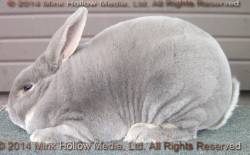 |
| 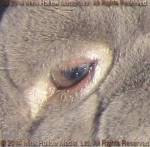 | fur |
| fur | 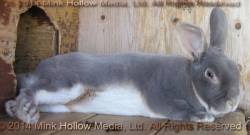 |
==== Red ====
Color is to be a rich, red buf, deep in tone, but without smudge. Color is to be as even as possible over the entire body, including belly. The ideal red Rex should have as little shading as possible, giving the appearance of being solid or self color.
Faults: Cut severely for white belly. (The ideal red carries the wideband gene which extends the midband to the ends of the hairs.)
|
==== Red ====
Color is to be a rich, red buf, deep in tone, but without smudge. Color is to be as even as possible over the entire body, including belly. The ideal red Rex should have as little shading as possible, giving the appearance of being solid or self color.
Faults: Cut severely for white belly. (The ideal red carries the wideband gene which extends the midband to the ends of the hairs.)
Disqualifications from competition: Blue or gray undercolor. A dark undercolor implies amber rather than red.
| 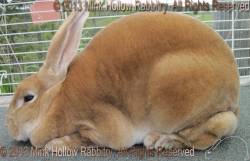 |
| 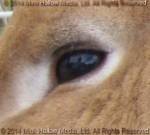 |
| 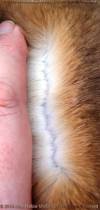 | other |
==== Sable ====
Saddle color is to be an even, rich sepia brown, shading gradually to rich chestnut on the flanks. Head, ears, legs, and upper side of tail are to match the saddle. Chest color is to match the flanks. Color is to go well down the fur shaft, with undercolor to match shadings throughout. Ruby cast over eyes permissible.
Faults: Streaks; splotches; white hair(s); rusty tinge.
| body | eye | fur | other |
==== Seal ====
Saddle color is to be a rich, dark sepia, shading only to slightly paler on flanks, chest, and belly. Color is to go well down the fur shaft, with undercoat to match shadings throughout. Saddle color is to extend from nape of neck to the tail. (True seal is of the chinchilla line, not black and chocolate together)
| other |
==== Sable ====
Saddle color is to be an even, rich sepia brown, shading gradually to rich chestnut on the flanks. Head, ears, legs, and upper side of tail are to match the saddle. Chest color is to match the flanks. Color is to go well down the fur shaft, with undercolor to match shadings throughout. Ruby cast over eyes permissible.
Faults: Streaks; splotches; white hair(s); rusty tinge.
| body | eye | fur | other |
==== Seal ====
Saddle color is to be a rich, dark sepia, shading only to slightly paler on flanks, chest, and belly. Color is to go well down the fur shaft, with undercoat to match shadings throughout. Saddle color is to extend from nape of neck to the tail. (True seal is of the chinchilla line, not black and chocolate together)
Faults: Rusty tinge.
Disqualifications from competition: Seals failing to show discernible shading in their coloration; blue undercolor.
| 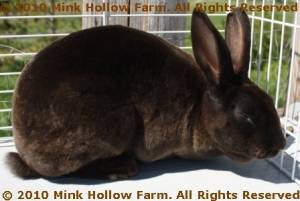 | eye |
| eye |  | other |
==== White ====
| other |
==== White ====
 Color is to be pure, clean white over the entire body.
Color is to be pure, clean white over the entire body.
Faults: Yellow cast; hutch stain; dirty; any color other than pure, clean white.
|  |
|  | fur |
| fur |  |
===== Disqualifications from competition (ALL Rex) =====
Eye color other than called for; white spot(s) in all colored varieties except broken.
|
===== Disqualifications from competition (ALL Rex) =====
Eye color other than called for; white spot(s) in all colored varieties except broken.
